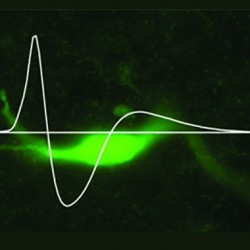By Helen Figueira
March 10, 2009
Time to read: 3 minutes
 Dopamine’s flip side?
Dopamine’s flip side?
Learning from mistakes is something to be encouraged. On the other hand, much of our development as individuals relies on the positive reinforcement of certain behaviours: things that are good for us, like eating food and having sex, actually feel good. This increases our imperative to seek out such stimuli in future situations.
In humans and many other animals the seat of this reward mechanism is the brain’s dopaminergic system, a network of neurons that fires when we get an unexpected reward, faciliting the brain restructuring or ‘neuronal plasticity’ that lends itself to learning. However, some experiments have indicated that brain dopamine levels also increase due to aversive stimuli such as those that are consistent with pain. This has led some researchers to postulate that dopaminergic neurons may be excited by all salient stimuli, rather than rewards alone – a hypothesis bolstered by research carried out a few years ago, which shows that excitation of the dopamine system is involved in fear conditioning.
One hypothesis proposed to reconcile these findings is that the termination of an aversive stimulus is itself an unexpected reward and might therefore excite dopamine neurons. Now, work published in the journal PNAS by members of the CSC’s Neurophysiology Group has put this idea to the test. The researchers identified dopamine neurons in a midbrain region of anaesthetized rats called the ventral tegmental area (VTA), and measured changes in their firing rate when aversive stimuli – in this case, electric shocks – were applied to a paw. Sure enough, they identified dopamine neurons in the upper or dorsal part of the VTA that exhibited a lower firing rate when the shocks were applied. Those same neurons also exhibited a marked increase in firing rate when the shock stopped. An increase in firing rate is consistent with what would be expected from an unexpected reward.
However, neurons also identified as dopaminergic, but which reside in the lower or ventral part of the VTA, were shown to increase their firing during the application of shocks. The anatomical distinction between these neurons and those in the dorsal VTA suggests a functional distinction: those in the ventral VTA appear to play a role in the processing of unexpected aversive events.
Demonstrating the existence of two functionally distinct dopamine systems in the VTA brings a novel resolution to some of the controversies surrounding the function of the dopamine system. It also extends our understanding of the underlying neurophysiological mechanisms that help us learn from our mistakes.
Reference:
Brischoux, F., Chakraborty, S., Brierley, D. I. I., Ungless, M. A. A., March 2009. Phasic excitation of dopamine neurons in ventral vta by noxious stimuli. Proceedings of the National Academy of Sciences of the United States of America.
Link to PNAS paper